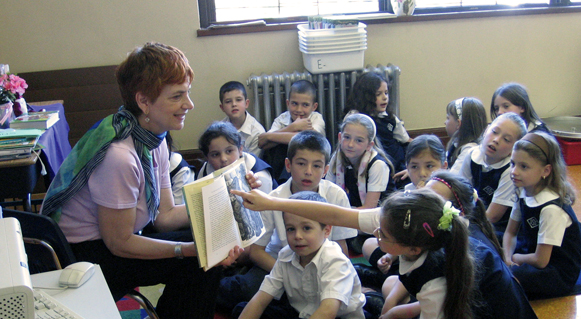I am sitting on one of the little wooden bench-like seats bolted onto the floor of my second-grade classroom in P.S. 72 (now Martin Luther High School) in Maspeth. It is the winter of 1954. Outside snow lies on the ground, but our class is in a wholly different clime. For as the clock was veering toward 2:30, our teacher, Miss Felber, announced that since we had been “so good” on this day, “we might …[and at this point she reached into her desk drawer to retrieve a thick, heavy book]… hear a bit more of THE WIZARD OF OZ”.
It wasn’t as if I was never read to at home. Every Sunday morning my father read to me the comics from the now long-defunct JOURNAL AMERICAN newspaper. Dad assumed different voices for all the characters – Dagwood Bumstead, Little Iodine, Snuffy Smith, and the others. I enjoyed these performances of his from an early age. But THE WIZARD OF OZ, as read by Miss Felber, bit by bit, sometimes with intervals of more than a week between readings, was another experience entirely. I lived on the yellow brick road with Dorothy, Toto and the friends they made along the way, seeing in my mind’s eye, more clearly than my myopic young self saw anything in the real world, the Emerald City, their destination. I didn’t really want them to ever reach it. It was enough to be on that road with them. My classmates must have felt the same way for there was utter silence as Miss Felber read; it was as if we were all in the same dream, one we didn’t wish to end.
It is more than 50 years later and I am again seated in an elementary school classroom, only this time it is I who am reading to a second-grade class. For me it feels a bit like being in a time machine for we are at St. Stanislaus Kostka School, just around the corner from old P.S. 72. Thanks to the good graces of its principal, Sister Rose Torma, I have had for the past seven years the privilege and pleasure of reading aloud on a regular basis to the second and third-graders here.
Like my classmates back in 1954, many of the pupils at St. Stan’s are the children of immigrants. But in contrast to my classmates, they are often bilingual and have a foot in two separate cultures, frequently traveling back and forth between their two countries. They also have a far better and more profound understanding of the external world, having already been exposed to much that the mass media and Internet offer. Invariably they want to know where the boundaries of fiction and non-fiction lie in a given book. For example, this year I am reading OLIVER TWIST to the third grade. A student raises his hand and asks, “Did these things really happen to the author, or did he make this all up?” Another adds, “Yes, it does seem like a made-up story, but I’m not sure…”
I explain that the book is not autobiography, but it is not entirely fiction either. The class is appalled at the conditions in Oliver’s workhouse. A smart girl named Shala raises her hand. “Isn’t this what we would call ‘child abuse’?” she asks. I agree that it is and a lively discussion follows about how social conditions can be changed, even today, and the fiction writer’s role in the process. This kind of interactive reading never occurred in my old classroom.
St. Stan’s is an ideal, heavenly place for reading aloud to children because here they are so imbued with a spirit of truth-seeking. Even the second-graders are a new kind of audience. They are always game for imagining different solutions to problems faced by characters in a storybook. Their imagined alternatives are often ingenious. (“Maybe the bunny could build himself water-skis to get across the river!”). But what I most admire is the zest these students display in re-plotting a story. They love to engage in the same creative process as the fiction writer, and so what we end up with is a whole variety of possible stories.
This was unthinkable back in my classroom of 1954. One thing, however, has not changed with the passage of years: the sheer delight with which each story-telling session is met. And at St. Stan’s, it’s not just my young listeners who greet each story read aloud as a wonderful new adventure. It is the reader as well.



